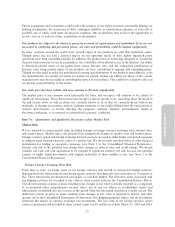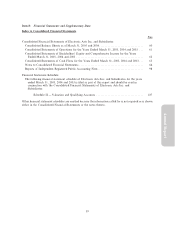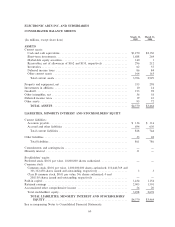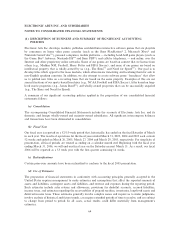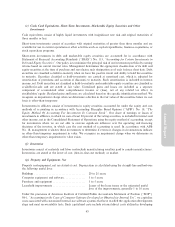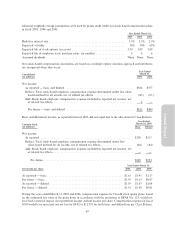Electronic Arts 2005 Annual Report Download - page 120
Download and view the complete annual report
Please find page 120 of the 2005 Electronic Arts annual report below. You can navigate through the pages in the report by either clicking on the pages listed below, or by using the keyword search tool below to find specific information within the annual report.ELECTRONIC ARTS INC. AND SUBSIDIARIES
NOTES TO CONSOLIDATED FINANCIAL STATEMENTS
(1) DESCRIPTION OF BUSINESS AND SUMMARY OF SIGNIFICANT ACCOUNTING
POLICIES
Electronic Arts Inc. develops, markets, publishes and distributes interactive software games that are playable
by consumers on home video game consoles (such as the Sony PlayStation» 2, Microsoft Xbox» and
Nintendo GameCube
TM
), personal computers, mobile platforms Ì including hand-held game players (such as
the Game Boy» Advance, Nintendo DS
TM
and Sony PSP») and cellular telephones, Ì and online, over the
Internet and other proprietary online networks. Some of our games are based on content that we license from
others (e.g., Madden NFL Football, Harry Potter and FIFA Soccer), and some of our games are based on
intellectual property that is wholly-owned by us (e.g., The Sims
TM
and Need for Speed
TM
). Our goal is to
develop titles which appeal to the mass markets, which often means translating and localizing them for sale in
non-English speaking countries. In addition, we also attempt to create software game ""franchises'' that allow
us to publish new titles on a recurring basis that are based on the same property. Examples of this are our
annual iterations of our sports-based franchises (e.g., NCAA Football and FIFA Soccer), titles based on long-
lived movie properties (e.g., James Bond
TM
) and wholly-owned properties that can be successfully sequeled
(e.g., The Sims and Need for Speed).
A summary of our signiÑcant accounting policies applied in the preparation of our consolidated Ñnancial
statements follows:
(a) Consolidation
The accompanying Consolidated Financial Statements include the accounts of Electronic Arts Inc. and its
domestic and foreign wholly-owned and majority-owned subsidiaries. All signiÑcant intercompany balances
and transactions have been eliminated in consolidation.
(b) Fiscal Year
Our Ñscal year is reported on a 52/53-week period that, historically, has ended on the Ñnal Saturday of March
in each year. The results of operations for the Ñscal years ended March 31, 2005, 2004 and 2003 each contain
52 weeks and ended on March 26, 2005, March 27, 2004 and March 29, 2003, respectively. For simplicity of
presentation, all Ñscal periods are treated as ending on a calendar month end. Beginning with the Ñscal year
ending March 31, 2006, we will end our Ñscal year on the Saturday nearest March 31. As a result, our Ñscal
2006 will be reported as a 53 week year with the Ñrst quarter containing 14 weeks.
(c) ReclassiÑcations
Certain prior-year amounts have been reclassiÑed to conform to the Ñscal 2005 presentation.
(d) Use of Estimates
The preparation of Ñnancial statements in conformity with accounting principles generally accepted in the
United States requires management to make estimates and assumptions that aÅect the reported amounts of
assets and liabilities, contingent assets and liabilities, and revenue and expenses during the reporting period.
Such estimates include sales returns and allowances, provisions for doubtful accounts, accrued liabilities,
income taxes, and estimates regarding the recoverability of prepaid royalties, inventories, long-lived assets and
deferred income taxes. These estimates generally involve complex issues and require us to make judgments,
involve analysis of historical and future trends, can require extended periods of time to resolve, and are subject
to change from period to period. In all cases, actual results could diÅer materially from management's
estimates.
64



